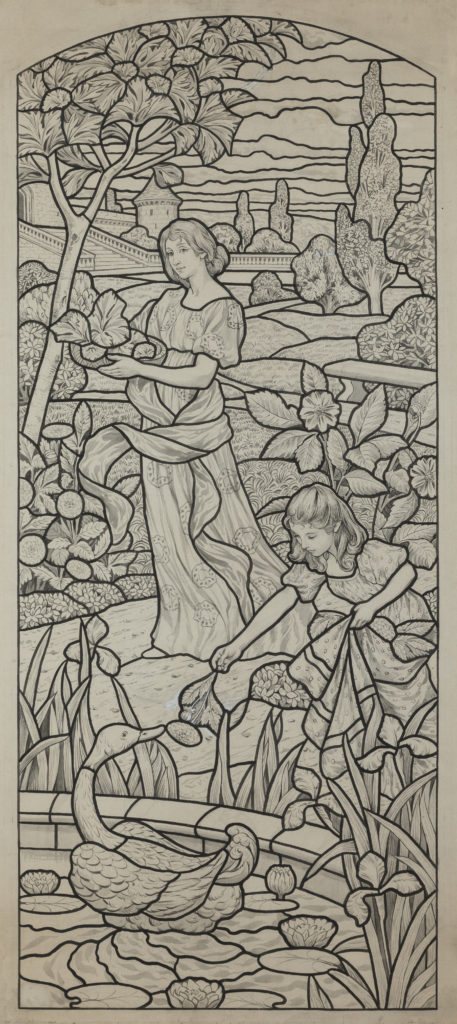This very impressive cartoon by Eugène Grasset for a stained-glass window is a new and significant recent discovery. Pioneer of the Art Nouveau and celebrated for his theories of ornamentation, Grasset produced many cartoons for stained-glass windows. His collaboration with Félix Gaudin, who executed most of these projects, was particularly fruitful, and they created together many decorations, for public institutions, various churches and for private houses too. The style of Grasset’s cartoon is highly recognizable: the influence of Pre-Raphaelite feminine silhouette, of Japanese print in the simplification of the composition, and of a highly decorative vegetation.
The composition is focused around a woman, carrying flowers, elegantly dressed, with wind in her veils, while trees and luxuriant vegetation surround her. The standing woman depicted in the present large sheet was a motif that Grasset repeated in different media: the same silhouette illustrates the month of September in Grasset’s calendar, La Belle jardinière (published in 1896 by G. de Malherbe); and is also represented in the panel Autumn of Grasset’s silk screen The Four Seasons (Petit Palais, Paris). There is a sketch by Grasset, which indubitably represents the same model (Private collection, ex-coll. Yves Plantin). In the stained-glass version, a little girl feeding a goose was added, with her hair well done and her dress and shawl moved by the wind. The landscape is widely open and gives a fresh impression of plein air. The present project could compare with two others stained-glass windows, for private clients, in the mid-1890’s: La Matinée de Printemps, ordered by Léon Chervrier for his manor in Chalon-sur-Saône (Musée des Arts Décoratifs, Paris); as well as Symphonie (location unknown) that are both also centred on an elegant woman. For a decorative artist, it is not unusual to create a pattern and to implement it in different artistic means. Between the lithography, the stained-glass and the silk, our drawing possess the most depth with beautiful shades. The talent of Grasset as a draughtsman is emphasized here: the intense black thick lines which are aimed at becoming the leads in the stained-glass are drawn in a way that leaves full visibility and harmony to the composition, while he constructs the shapes and texture with light grey/green touches. The same technique is visible in the artist’s cartoons at the Musée d’Orsay, such as Jeanne d’Arc (cartoon for the church Saint-Honoré d’Eylau). The same kind of small retouches in white body color is also noticeable.
This drawing is a testimony of Grasset’s remarkable exploration in the representation of vegetal elements for decorative purpose. The artist gathered and published his research in this field in 1897 in La Plante et ses Applications, a reference for Art Nouveau design, displaying a rich and beautiful variety of flowers, plants and trees. Grasset, through all his creations, progressively created a vocabulary of vegetal shapes for a unique atmosphere.
It is not surprizing that the present sheet formerly belonged to Yves Saint-Laurent and Pierre Bergé.







